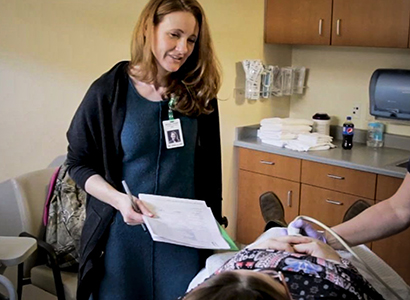Voices of U of U Health
Reimagining Prenatal Care: A Case for Telemedicine
The prenatal care our daughters receive should be markedly different from the prenatal care that our grandmothers received. We want to move beyond the "one size fits all” approach to adopt new prenatal care strategies that provide evidence-based care at the lowest cost, while retaining high patient satisfaction.

In 1989, the U.S. Department of Health and Human Services (HHS) recommended a reduced-frequency prenatal schedule for low-risk pregnant women. Based on several randomized trials demonstrating safety, the recommended number of visits were reduced from 14 to 8. The HHS proposal was backed by the American Congress of Obstetricians & Gynecologists and the American Academy of Pediatrics. Despite these recommendations, twenty years later, the average number of prenatal visits has not been reduced. Concerns regarding patient and provider satisfaction, among others, limited widespread use of a reduced prenatal care model for low-risk pregnancies. Modernizing the "sacred ground" of obstetric care has proven to be an enormous challenge.
A Step Forward for Patient-Centered Care
In the department of Maternal-Fetal Medicine, we see an opportunity to reject dogmatic status quo and improve prenatal care from an evidence-based standpoint. So we conceived of a step forward that would move us toward patient-centered care, while retaining patient satisfaction and quality.

We designed a clinical trial in which 200 women were randomly-selected to receive either traditional prenatal care or a virtual prenatal care strategy. Virtual care retained the same number of overall visits but effectively reduced the number of face-to-face clinic visits by incorporating virtual visits. The five face-to-face visits were structured as goal-oriented visits and allowed for evidence-based labs, ultrasound, and physical exams. The remaining visits were virtual, in which patients self-collected information such as weight, blood pressure, and fetal heart rate and then met with their physician or midwife via telemedicine. Patient satisfaction was the primary outcome. At the conclusion of the trial, overall satisfaction with prenatal care was no different between traditional care and virtual care groups (97% versus 100%). In other words, high patient satisfaction was retained using a new and novel method of prenatal care, demonstrating programmatic feasibility and directly addressing the patient satisfaction concerns raised in prior clinical trials. The University of Utah Health Virtual Prenatal Care Program has now been launched as a new prenatal care initiative.
Virtual Care is More Convenient & Saves Time
It's no surprise that, more than anything else, patients like the convenience and time-savings that the telemedicine program affords them. Virtual prenatal care is a market differentiator for University of Utah Health and patients are seeking it out. While patients have been early and enthusiastic adopters, providers and staff have been somewhat more hesitant to embrace change. Widespread programmatic adoption remains a challenge. Other challenges that need to be tackled include reaching pregnant women without easy access to technology for virtual visits and creating a strategy for higher-risk pregnant women.
Other institutions are looking to replicate U of U Health’s virtual prenatal care program. With nearly 4 million births annually in the United States, prenatal care is one of the most widely used preventive health care strategies. We are working to improve it.
